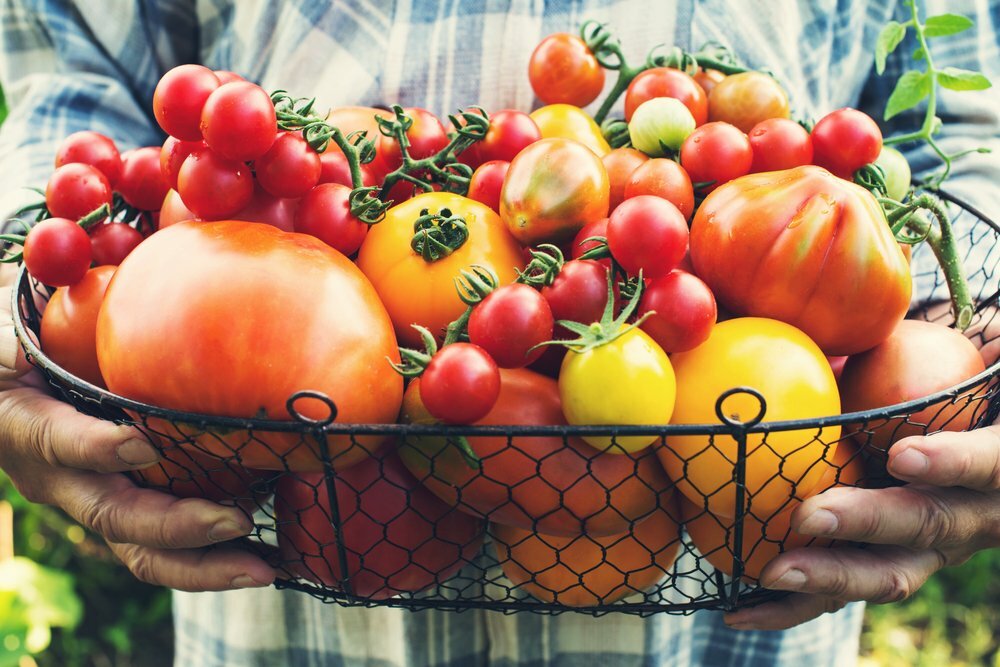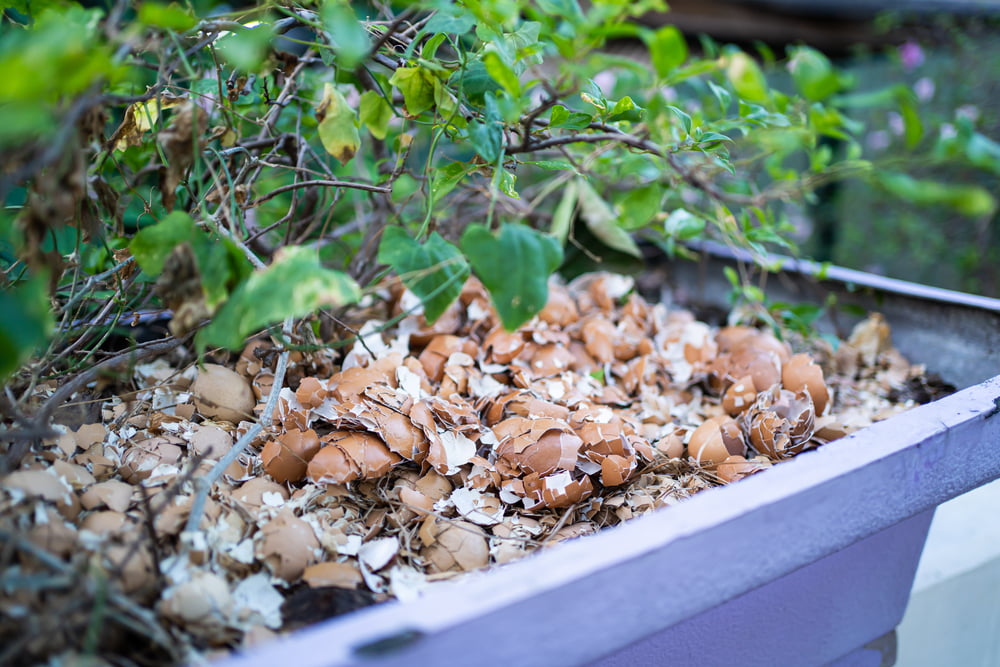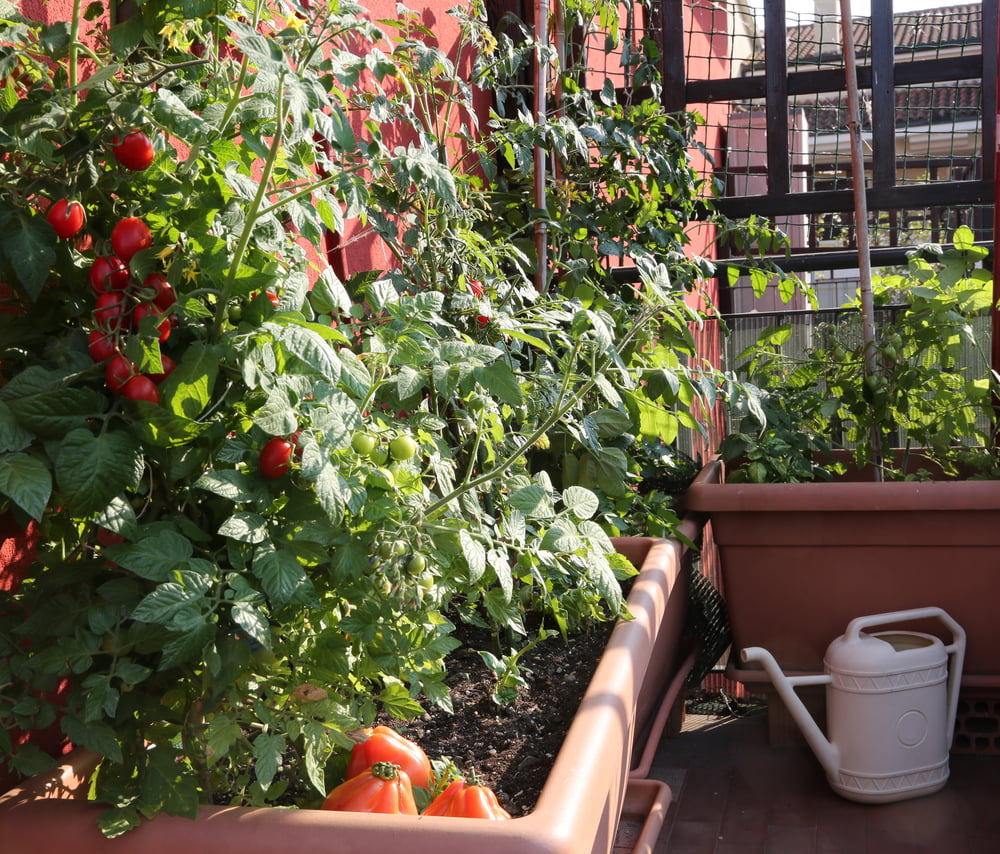Tomato plants are a wonderful veg to grow in the garden this year. Not only do garden fresh tomatoes taste amazing, but they are a nutritional powerhouse too.
Did you know that juicy red tomatoes are made of about 95% water and can help us get the daily water intake we need? What a flavourful way to stay hydrated! To keep your tomato plants healthy and happy though, you’ll want to be vigilant about watering them on a regular basis. In this article, let’s talk about all the ins and outs of watering your tomato plants, so you can enjoy all the benefits they have to offer.

The Best Source of Water: Rainwater
Ever notice that your plants grow greener and more abundantly after a good rainstorm? Rainwater is, of course, the best source of water for your plants, since it tends to contain fewer manmade chemicals, is relatively salt-free, and comes with an ideal pH for plant growth.
Rainwater is the preferred method for watering tomato plants, as it is full of oxygen, atmospheric nitrogen, and electrically conductive negative ions (called anions). The nitrogen in rainwater is in the form of nitrate, which will supercharge your plant’s ability to thrive. After diffusing into the soil, this source of nitrogen is the most bio-available form plants can utilise. Due to rainwater being oxygenated, your plants will be able to take up oxygen molecules via their root systems.
Negative ions are molecules derived from the electrolytes of aerosolised minerals. They are diffused into the air and also seep into the ground when it rains. Negative ions have a positive effect upon human and plant health. In humans, negative ions increase serotonin, alleviate stress, boost energy, and give us a general sense of well-being. In plants, negative ions boost growth, stature, and fruiting. Essentially, rainwater fertilises your tomato plants.
A good drizzle not only hydrates tomato plants but also serves the purpose of cleaning them too. As the rain falls, it carries away dirt, dust, and debris. This process cleans out the stomata (pores) of the plant, which enables it to respire better and take in CO2 more efficiently. From this, the plant is then able to undergo photosynthesis.
Conversely, tap water from the hose is likely to have added salts, chlorine, and micro-pollutants from human activity; all of which can build up in the soil over time. Now, tap water can help plants access nitrogen in the soil through a process called mineralisation, but it doesn’t come close to what rainwater can do.
For all these reasons, it’s a good idea to harvest rainwater for your tomato plants and continue to use it as the days go by after a rainstorm. Now if you can’t do rainwater harvesting due to drought, simply fill a large bucket of municipal water and set it outside to dechlorinate for a day or two. Be sure to cover the water reservoir with a wire mesh to keep out mosquitoes and other pests. Also, when you can, use soft water.

When and How to Water Your Tomato Plants
How we water our tomato plants is important. Here’s why, not watering tomato plants in the right fashion can lead to a whole host of health problems for your plants and make them vulnerable to infections. Therefore, when watering your tomato plants, you want to water at the base of the plant. This practice will help reduce flower loss, the risk of powdery mildew, and other plant ailments.
On days without natural rainfall, the best time to water your tomato plants is in the early morning and/or late evening. Watering tomatoes in the morning enables your plants to have a long cool drink before sunrise.
Plus, if any moisture gets on the leaves, it gives the tomato plant plenty of time to dry off before the heat of the afternoon sun arrives, as waterlogged leaves can suffer from sun scalding. With the arrival of daytime winds and the gentler early morning sun, your tomato plants will have the chance to dry further.
Watering plants in the evening gives them all night to drink in the water and cool down. At this time, tomato plants focus on respiration, faster growth, tissue repair, and producing fruit.
Also note, watering during the day can cause tomato fruit to split open or develop fissures. So be sure to water your plants at the appropriate times.

How Much Water Should Tomatoes Receive?
For the most optimal growth and health of your plant, you’ll want to check on your tomato plants at least twice a day.
Give your tomatoes a good long drink, about 1 gallon of water per mature plant is ideal depending upon its current soil moisture.
To check soil moisture, the best rule of thumb is to feel the surface soil and also poke down about 2 inches into the soil to see if it is moist to the touch. If the soil is dry, it’s time to water again. If it’s somewhat moist a few inches down, you can wait until the evening to water. If it’s very moist, even in the evening, don’t water, and wait until the following morning to test the soil again.

When the soil is already moist, we don’t want to water the plant again, as overwatering tomatoes can be just as damaging as sparse watering. If the roots of your tomato plant become waterlogged, they may begin to rot. For this reason, tomato plants must be housed in well-draining soil. Additionally, it benefits your tomatoes to mulch around the base of the plant, as this will help the soil retain the right balance of moisture.

Conclusion
Juicy sweet tomatoes are one of the highlights of summer! We just have to remember to water our tomato plants regularly.
With our busy schedules and hectic lives, it can be easy to forget about our plant friends. To help you remember when to water your tomato plants, you can always set reminders on your phone. In this way, you’ll always provide your tomato plants with the ideal amount of water and ensure that the steady flow of tasty tomatoes lasts all season.

